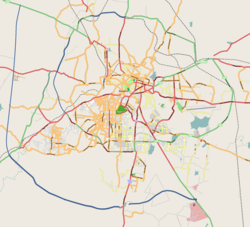Bengaluru | |
|---|---|
Neighbourhood | |
 | |
| Coordinates: 12°57′46″N 77°34′33″E / 12.9627°N 77.5758°E | |
| Country | |
| State | Karnataka |
| District | Bangalore Urban |
| Metro | Bengaluru |
| Area | |
| • Total | 2.24 km2 (0.86 sq mi) |
| Elevation | 900 m (3,000 ft) |
| Languages | |
| • Official | Kannada |
| Time zone | UTC+5:30 (IST) |
Bengaluru Pete is the area of Bangalore city[1] which was established by Kempegowda I (c. 1510–1570) in 1537 with roads laid out in the cardinal directions, and entrance gates at the end of each road.[1] Kempegowda also termed the Pete he built as his "gandu bhoomi" or "Land of Heroes". Pete (Kannada: Market centre) forms a well–defined body of markets which were associated with various trades and professions of the populace in the locality markets and given the names of trades pursued in such markets. The well known markets are the Tharagupete–market for grains, the Balepete – for Bangles and musical instruments, the Chikkapete and the Nagarthpete for textile trade, the Ballapurpete and the Ganigarapete market where oil is extracted by people of the Ganiga community, the Tigalarapete–flower market of gardeners, the Cubbonpete – textile manufacture by people of the Devanga community.[1]
The Bengaluru Pete, established in 1537 around the Mud Fort, built by Kempe Gowda I as the nucleus, with an area of 2.24 square kilometres (1 sq mi), has expanded to the present sprawling city of 741 square kilometres (286 sq mi) embracing a multi ethnic population of 5.7 million; as per Census of India 2001,[2] the present population is reported as 6.6 million (2007) and is thus known by the epithet "the Boom city". The other nicknames of the city also reflect the growth direction of the city, such as the Silicon Valley of India, the "Fashion Capital of India," and "The Pub City of India."[1][3][4]
The old Pete, structured in the contemporary style of deep networks of crowded streets, richly represented the multi cultural identity, social history, and economic geography of the times which are considered as a hallmark in the planning and design of any urban agglomerate. The place has left its mark on literature with novels like Riddle of the Seventh Stone[5] being set in this part of Bangalore. These attributes have been further accentuated in the present day Bangalore city.[1] It is now the third largest metropolis in India,[6] the largest city in Karnataka state and the 28th largest city in the world.[7]
- ^ a b c d e Rajagopal, Champaka (Spring–Summer 2008). "Bangalore: The informal economy of the Historic Pete" (PDF). Journal of the Development and Research Organization for Nature Arts and Heritage. V (1). Indian Heritage Cities Network: 137–46. Retrieved 7 February 2009.
- ^ "Census population" (PDF). Census of India. www.cicred.org. pp. 6&21. Retrieved 7 March 2009.
- ^ "Bangalore". Archived from the original on 29 June 2011. Retrieved 6 March 2009.
- ^ "About Bangalore". Department of Bangalore IT and Biotechnology, Government of Karnataka. Archived from the original on 19 September 2006. Retrieved 5 March 2009.
- ^ Madhukar, Jayanthi (18 October 2010). "Into B'lore's underbelly". Bangalore Mirror. Archived from the original on 7 October 2011. Retrieved 29 May 2012.
- ^ "India: largest cities and towns and statistics of their population". World Gazetteer. Retrieved 7 March 2009.[dead link]
- ^ "World: largest cities and towns and statistics of their population". World Gazetteer. Archived from the original on 1 October 2007. Retrieved 7 March 2009.
{{cite journal}}: Cite journal requires|journal=(help)
© MMXXIII Rich X Search. We shall prevail. All rights reserved. Rich X Search


